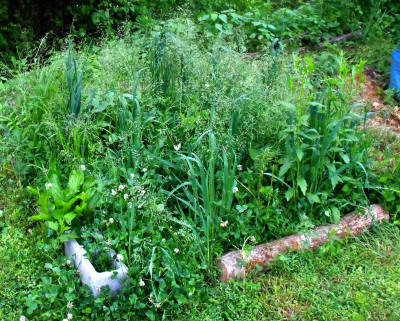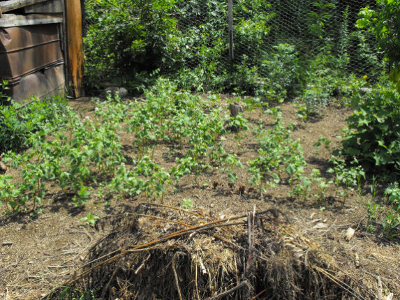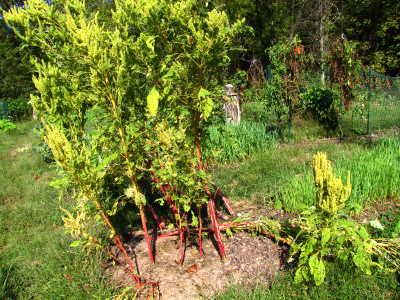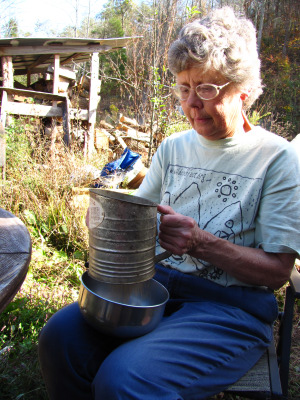
Backyard grain experiments
 In
the garden, one of our biggest experiments in 2010 was embarking on the
first stage of experimentation with grain. We tried a do-nothing
oats bed, grew amaranth and quinoa in the vegetable garden, and tried
out buckwheat and oats in the chicken pasture. We learned a lot,
but we still have a long way to go before we achieve grain independence.
In
the garden, one of our biggest experiments in 2010 was embarking on the
first stage of experimentation with grain. We tried a do-nothing
oats bed, grew amaranth and quinoa in the vegetable garden, and tried
out buckwheat and oats in the chicken pasture. We learned a lot,
but we still have a long way to go before we achieve grain independence.
First, I have to admit
that our eating habits changed dramatically in the middle of our grain
experiment, which veered my priorities away from grain. After
extensive research, I decided that we needed to increase the percentage
of protein in our diets. Since I wasn't going to cut back on
fruits and vegetables, that meant reducing our carbohydrates to leave
more room on our plates for beans and meat. Growing oats suddenly
seemed much less important once I stopped eating them for breakfast,
and other grains were similarly sidetracked to the chicken feed
category. But we both felt that the change was a plus since we
started feeling perkier, our brains flowed faster, and we even lost
some weight.
 That said, we learned a lot
about growing grains anyway. Our do-nothing
patch (first photo)
wasn't very successful --- leaving the chicken tractor on a patch of
ground for a week in the winter is not enough to kill off the weeds,
and the oats had a lot of competition and ended up patchy and
scrawny. A more effective do-nothing method turned out to be planting
grains in a paddock of the chicken pasture that was scratched bare over
the early summer and then had the last few hardy weeds hoed out
by hand. Of course, growing grains in the vegetable garden
was easy, but seemed like a waste of space since the plants were hardy
enough to put up with the minimal work chicken pasture situation.
That said, we learned a lot
about growing grains anyway. Our do-nothing
patch (first photo)
wasn't very successful --- leaving the chicken tractor on a patch of
ground for a week in the winter is not enough to kill off the weeds,
and the oats had a lot of competition and ended up patchy and
scrawny. A more effective do-nothing method turned out to be planting
grains in a paddock of the chicken pasture that was scratched bare over
the early summer and then had the last few hardy weeds hoed out
by hand. Of course, growing grains in the vegetable garden
was easy, but seemed like a waste of space since the plants were hardy
enough to put up with the minimal work chicken pasture situation.
In terms of variety
selection, the results were once again a mixed bag. I was
intrigued by hullless oats, but in practice found that they were much
more finicky than traditional oats. I can't draw many conclusions
from the failure of hullless oats in the do-nothing patch, but I did
grow side by side hullless and traditional oats as cover crops starting
in August and the former achieved a height of perhaps a third the size
of the latter. I suspect that it's better to just grow
traditional oats and find a way to hull them if you want to eat them
yourselves.
 In
the unusual grain category, quinoa
was a flop ---
perhaps I need to try another variety? On the other hand, Manna
de Montana Amaranth was extremely productive, and grew so tall that I
suspect I could grow it in the chicken pasture and let the flock graze
between the plants without worrying about them reaching the
seeds. Amaranth was also very easy to thresh and winnow, although I'm still learning
how to cook it.
In
the unusual grain category, quinoa
was a flop ---
perhaps I need to try another variety? On the other hand, Manna
de Montana Amaranth was extremely productive, and grew so tall that I
suspect I could grow it in the chicken pasture and let the flock graze
between the plants without worrying about them reaching the
seeds. Amaranth was also very easy to thresh and winnow, although I'm still learning
how to cook it.
Back among traditional
grains, we're experimenting with growing
wheat this winter,
but the jury is still out. I have enough data about buckwheat, though, to say that it's a
so-so grain that I probably won't repeat (except as a cover
crop.) Buckwheat did relatively well in the chicken pasture, but
complained about drought --- I think that for maximum yields, I  should
plant it in a part of the garden that gets irrigated. On
the other hand, buckwheat wasn't a fan of the waterlogged soil where I
grew it as a cover crop. The plants also didn't seem to produce
all that much grain, and it would have been tough to pick the
individual seeds if I hadn't just turned the chickens in to eat it
up.
should
plant it in a part of the garden that gets irrigated. On
the other hand, buckwheat wasn't a fan of the waterlogged soil where I
grew it as a cover crop. The plants also didn't seem to produce
all that much grain, and it would have been tough to pick the
individual seeds if I hadn't just turned the chickens in to eat it
up.
Looking toward the
future, our grain patches next year will look very different. The
only grains we eat much of nowadays are a bit of rice and wheat, but
since I can't grow the former I'll be planting wheat and amaranth for
our table. For the chickens, I want to try out millet and field
corn, but will focus more on the high protein sunflower seeds and
perhaps some sort of legume. My hope is that I can continue to
grow our grains in the two chicken pasture paddocks which are on flat
ground, utilizing the chickens to prepare the soil for me and to delete
most weeds.
This post is part of our 2010 experiments lunchtime series.
Read all of the entries:
|
Want more in-depth information? Browse through our books.
Or explore more posts by date or by subject.
About us: Anna Hess and Mark Hamilton spent over a decade living self-sufficiently in the mountains of Virginia before moving north to start over from scratch in the foothills of Ohio. They've experimented with permaculture, no-till gardening, trailersteading, home-based microbusinesses and much more, writing about their adventures in both blogs and books.
Want to be notified when new comments are posted on this page? Click on the RSS button after you add a comment to subscribe to the comment feed, or simply check the box beside "email replies to me" while writing your comment.

This will be the year I get my amaranth planted... I can feel it.
As an aside, do you ever notice that posting comments goes really slowly from the time one clicks the "post comment" button to the time it actually returns to the page? Or is it just me?
You should go for it --- amaranth was really one of the easiest things I grew all year!
Sorry about the slow comments. I have a sneaking suspicion that the underlying software has to rebuild some large part of the website when people make comments, and as we add more and more pages to the site, everything gets slower and slower...
I'm not sure if the variety you're looking at would be the best bet. Amaranth comes in many different varieties (and even species.) Some have been bred as ornamentals (which is what yours sounds like with its pretty pink fronds), others to be eaten as greens, and yet others to be used as cereals. My research suggests that you should look for a variety that is listed as a cereal and has pale (instead of dark) seeds for best flavor.
I'm not sure how tall my amaranth was supposed to get, but I'd say it got to five or six feet. The seed packet had very few seeds in it --- maybe a dozen? A few didn't come up or didn't make it past the seedling stage, so my patch was around 10 plants, which gave me 3.5 cups (so, about a third of a cup per plant.)
I did try popping the seeds, and that was actually our best tasting experiment yet. Amaranth seeds don't get big like popcorn does, though, so you have to pop a lot to get anything. I added mine to melted chocolate, and it was luscious. (But what wouldn't be?)